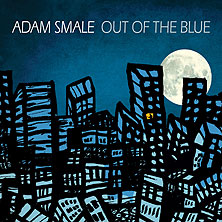 Guitar
jazz continues to bloom as a still growing musical art form and for
fans of the genre, Out Of The Blue is a fine 2014 release
from guitarist Adam Smale. On the nine track Out Of The
Blue, Adam pairs his 7 string guitar sound with a fine crew of
musicians and the results make for an upbeat album of bop-friendly,
guitar-centric instrumental music. Adam cites fretboard heroes like
Lenny Breau, Chet Atkins, Pat Martino and Pat Metheny among his big
influences and before he moved to NYC, Adam even got to work with
Lenny Breau sideman, bassist Don Thompson. Some of the Out Of The
Blue tracks, especially track five “Night Drive”, are
somewhat rock oriented while track three, “Yes Or No”, by
Wayne Shorter, is the only cover on the all original track lineup
here. Commenting on living in NYC, Adam tells mwe3.com, "There
is so much great talent funneled into the New York scene, you can’t
help but be inspired. Plus, there is something about being here in
NYC that changes your playing. I can’t explain it. You absorb
both the sounds and energy, and some music history when you’re
here long enough." In the CD packaging Adam provides a track
by track account of the album song list while extensive liner notes
by Bill Milkowski features interview quotes from the guitarist
that takes you on a guided tour of his guitar history. If you enjoy
modern instrumental jazz guitar with a number of diverse influences
and styles, give a listen to Adam Smale’s Out Of The Blue.
www.AdamSmale-Jazz.com
Guitar
jazz continues to bloom as a still growing musical art form and for
fans of the genre, Out Of The Blue is a fine 2014 release
from guitarist Adam Smale. On the nine track Out Of The
Blue, Adam pairs his 7 string guitar sound with a fine crew of
musicians and the results make for an upbeat album of bop-friendly,
guitar-centric instrumental music. Adam cites fretboard heroes like
Lenny Breau, Chet Atkins, Pat Martino and Pat Metheny among his big
influences and before he moved to NYC, Adam even got to work with
Lenny Breau sideman, bassist Don Thompson. Some of the Out Of The
Blue tracks, especially track five “Night Drive”, are
somewhat rock oriented while track three, “Yes Or No”, by
Wayne Shorter, is the only cover on the all original track lineup
here. Commenting on living in NYC, Adam tells mwe3.com, "There
is so much great talent funneled into the New York scene, you can’t
help but be inspired. Plus, there is something about being here in
NYC that changes your playing. I can’t explain it. You absorb
both the sounds and energy, and some music history when you’re
here long enough." In the CD packaging Adam provides a track
by track account of the album song list while extensive liner notes
by Bill Milkowski features interview quotes from the guitarist
that takes you on a guided tour of his guitar history. If you enjoy
modern instrumental jazz guitar with a number of diverse influences
and styles, give a listen to Adam Smale’s Out Of The Blue.
www.AdamSmale-Jazz.com
mwe3.com presents an interview with
ADAM SMALE
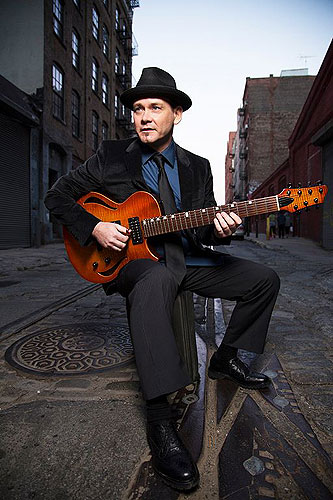 mwe3:
Tell us about growing up in Canada and when did you make the move
to live in NYC and what do you like best about living in New York
and how does it influence your guitar playing and overall sound?
mwe3:
Tell us about growing up in Canada and when did you make the move
to live in NYC and what do you like best about living in New York
and how does it influence your guitar playing and overall sound?
Adam Smale: I grew up in a very small, rural community in Northern
Ontario. Bar River, is about a 40 minute drive east of Sault Ste.
Marie, Ontario. It was mostly farm country. Even by the time I grew
up in the 1970s decade, farming was declining. Now very few people
actually farm. My parents actually bought three acres of property
inside of a cornfield. When I was young, 3 sides of out property was
surrounded by corn. No “Children of the Corn” jokes, please!
You wouldn’t even know that it was a cornfield there now it’s
so grown in. When you grow up in that kind of environment, there’s
very little for young kids to do. Drugs, alcohol, and partying is
often the pastime that some get sucked into. Luckily, I started playing
guitar at 7 years old. That was my drug. I would soon begin playing
guitar any chance I could. I’d take it to school, I’d take
it to family functions, and I’d play in the back seat of the
car when we went into town. I didn’t even know I was practicing.
I just enjoyed playing so much I just played all the time. My parents
had to physically remove it from my hands and tell me to go to bed
sometimes. By 12 years old I joined the musicians union and started
gigging. I have been performing ever since.
I first moved to the U.S. in 2007 to begin a Masters degree in Jazz
Performance, at Western Michigan University, in Kalamazoo, MI. When
I finished my degree in 2009, I moved to NYC right after graduating.
There is so much great talent funneled into the New York scene, you
can’t help but be inspired. Plus, there is something about being
here in NYC that changes your playing. I can’t explain it. You
absorb both the sounds and energy, and some music history when you’re
here long enough. Unless you live here, you won’t get what I’m
saying. New York has a fantastic jazz legacy that still lingers in
the notes people play today. At least the great players, the ones
that I dig anyway.
mwe3: What was your mission on Out Of The Blue and how
do you feel the CD defines your guitar sound and your approach to
music in general?
Adam Smale: My mission was to just simply put out the best
recording I possibly could. So I gathered my best songs, found a fantastic
studio, Water Music, Hoboken, New Jersey, hired an award wining engineer
to record and mix the project, and hired some of the best musicians
I knew. I hosted a funding campaign through Rocket Hub, to aid in
offsetting some of the cost. It’s expensive to make a good record.
As far as guitar sound goes, you never exactly capture “your
sound” in the studio. Although, the engineer, George Petit, did
a fantastic job, mainly my guitar sound has been refined a little
since then. For one, my pedal board doesn’t even resemble the
one I used for the recording. I recently became a Strymon endorsed
artist and they have just absolute killer pedals the really help maintain
my tone without coloring it. I am now on the lookout for a new amplifier.
I am always looking for that perfect platform that enhances what you
already have, not changes it to something else. I’m really picky.
If I was rich rock star I’d have the gear that I wanted. But
us jazz guys have to either go in debt, or build your gear up slowly
over time; or somewhere in between. Ha!
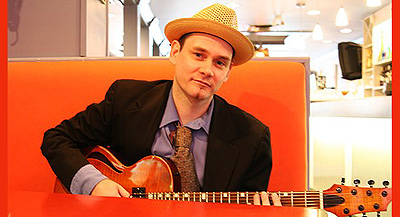 mwe3:
You say your playing was very influenced by guitar legend Lenny Breau.
What do you like best about Lenny’s guitar playing and how would
you describe Lenny’s influence on you and the guitar world overall
and what albums of his did you like the most?
mwe3:
You say your playing was very influenced by guitar legend Lenny Breau.
What do you like best about Lenny’s guitar playing and how would
you describe Lenny’s influence on you and the guitar world overall
and what albums of his did you like the most?
Adam Smale: Lenny Breau, in many ways, broke new ground in
jazz guitar techniques. He really was a true genius and it’s
sad that most of the world, including jazz musicians, don’t know
who he was or the contributions to jazz guitar he made as a whole.
Part of that reason is there sadly isn’t too many recordings
of Lenny when he was at his best. Wes Montgomery knew. To paraphrase
what Wes told George Benson: “Forget what I’m doing. Check
this guy out up in Canada.” He was referring to Lenny, of course.
Lenny is someone who took the harmonic approach of jazz pianists and
Bill Evans, as well as McCoy Tyner later on, and mixed all that up
with a background in country music, guitarist Chet Atkins, and Flamenco
guitarist Sabicas, to come up with a fresh approach to jazz guitar.
And this was in the ‘60s! And that’s just a start. He was
told that it was impossible to do what a jazz pianist does on guitar.
But he showed us all it can be done. No one has come close to the
technique of accompanying yourself while you improvise a solo, as
a pianist does, like Lenny. His chord voicings could be so lush at
times too.
I would have to pick 3 albums: 1) The Hallmark Sessions (recorded
in 1961, released 2003) This is such a great recording because you
get to hear Lenny when he was young and just beginning to apply his
new approach. He’s young, raw, and full of energy.
2) Guitar Sounds From Lenny Breau (1968) It was Lenny’s
first big break, being recorded in Nashville by his guitar hero, Chet
Atkins. Seven years after The Hallmark Sessions, you can hear
Lenny has matured as a player.
3) Live at Bourbon St. (1995) You hear Lenny on top of his
game here. Recorded just months before his death in 1983, it’s
a live recording in a duo setting with bassist Dave Young. Because
of the lack of instrumentation, you can really hear everything Lenny
is doing and how deceptively easy he makes it all sound.
 mwe3:
What were your early guitar studies like in Canada and would you say
you were more influenced by jazz than rock especially as your new
CD Out Of The Blue is very much rooted in the jazz guitar style? How
about the influence of rock guitarists on your sound and can you cite
some of the differences between the rock and jazz guitar styles?
mwe3:
What were your early guitar studies like in Canada and would you say
you were more influenced by jazz than rock especially as your new
CD Out Of The Blue is very much rooted in the jazz guitar style? How
about the influence of rock guitarists on your sound and can you cite
some of the differences between the rock and jazz guitar styles?
Adam Smale: My early studies were taking lessons at a music
lesson place learning mostly out of the classic Mel Bay books starting
at age 7. I am grateful that I learned how to read music. It set a
good foundation However, I learned more things on my own. By the time
I was 9 or 10, I was learning some songs off of my dad’s record
collection. It’s funny because even then it was guitar instrumentals
I was learning. Some guitar boogie woogies, surf guitar stuff like
The Ventures, and eventually Chet Atkins. My dad had a book and accompanying
record called Hum and Strum Along with Chet. That was a big
part of learning to play fingerstyle. Eventually I started learning
bluegrass tunes and also played 5-string banjo in my teens which also
influenced my fingerstyle approach, I’m sure.
Later as I entered my teens I was checking out Billy Gibbons from
ZZ Top, Eric Clapton, and the guys from Aerosmith, bluesy type of
rock ‘n roll. Then around 16 I heard Edward Van Halen. Even though
I was still playing country on the weekends in the band, I was immersed
in Eddie’s playing during the week. Out went the thumbpick for
many years. I never really wanted to sound like him, but I would jam
along to the recordings. It wasn’t just his incredible virtuosity,
it was his tone, feel, and impeccable time as well. His energy was
just incredible. He was very influential to me as a musician then,
I am sure something from him remains in my playing today even though
I don’t sound anything like him.
mwe3: Who else were among your big guitar influences? I was
surprised that the only non original on Out Of The Blue is
“Yes And No” by Wayne Shorter who played in Weather Report.
How easy or difficult was it to transcribe that track for guitar and
in what ways did Wayne Shorter influence, both as a solo artist and
in Weather Report influence your guitar playing and music writing?
Adam Smale: You could say anything I ever learned or heard
has influenced me. But that’s too short of an answer. Right?
Lester Flatt and Earl Scruggs were as much of an influence, along
with all the country songs - old school country or the rock tinged
country of the day back then - as Chet Atkins, Albert Lee, and Eddie
Van Halen was. It was Eddie Van Halen that got me playing jazz. He
was always going on about Alan Holdsworth. When I heard Holdsworth
at 19, my jaw hit the floor. I couldn’t even imagine guitar,
music, or an ensemble could even sound like that. That’s when
I decided I had to go to school to study music. So you could say Holdsworth
is a bit of an influence in playing and in influencing my decision
to “get educated.” Much later, Lenny Breau, Ed Bickert,
and Lorne Lofsky. Then within the last 10-12 years, Tal Farlow, Kurt
Rosenwinkel, and Pat Martino.
As far as “Yes And No” goes, I already knew the song. I
had been playing it for 20 years. But for this recording I wanted
to put my own twist on it. So I reharmonized the chords to create
more movement when the melody line is sparse. It goes through 3 different
feels as well. It starts off in a very modern jazz sound, then to
bebop swing, back to modern, then even an 6/8 Afro vibe, switching
back and forth. It can sound forced or schizophrenic when you are
changing feels throughout a tune sometimes, but I think it works on
this arrangement. I would say that Wayne Shorter has been more of
an influence as a composer more than a player. In my formative years
I never listened to Weather Report. But I do think they were one of
the best bands to come out of the fusion era.
 mwe3:
Who plays with you on the Out Of The Blue CD and how did you
meet up with your band mates and what other musicians do you play
with live in NYC?
mwe3:
Who plays with you on the Out Of The Blue CD and how did you
meet up with your band mates and what other musicians do you play
with live in NYC?
Adam Smale: The personnel I recruited are all friends. I first
met drummer Keith Hall, at Western Michigan University. He was, and
still is a faculty member there. I then got to know bassist Phil Palombi,
and pianist Matthew Fries through Keith. These guys have a long history
together. They originally were band members in Curtis Stigers group,
of which Keith and Matthew still are. Since they noticed the chemistry
they felt, as well as the camaraderie they had, they decided to form
their own group, Tri-Fi. They used to visit the WMU and Kalamazoo,
regularly.
I also play the odd gig in town with other people. I also have a regular
gig at Antibes Bistro that I play in a trio setting in the Lower Eastside
of Manhattan that I have had for 2 years. That band often has different
people rotating in and out, but recently it has been mostly bassist
Michael O’Brien and drummer Brian Fishler. These guys are a treat
to play with in a trio format. I hope to be using them more often
in the future for other gigs.
I also am a member of Fleur Seule (www.fleurseule.com),
an upcoming group that has been creating some buzz lately in and around
town. The band performs classic Swing and some Latin tunes from the
1930s, 40s, and 50s, but with just an ever so slight modern twist,
very slight. There is a following of swing dancers that attend our
gigs. It’s a fun band, and sometimes the dancing is really exciting
to watch. Sometimes I get lost in the chart because I am watching
the dancers instead of the chart.
mwe3: Track 4 on Out Of The Blue is called “Jazzenco”
and it merges jazz with flamenco and Afro-Cuban music. How does the
flamenco and Afro-Cuban influence come into play in your music?
Adam Smale: The groove that we use in the solo section on “Jazzenco”
is more Afro 6/8 than Cuban. Although there is some common DNA there.
I have always enjoyed the traditional music from Cuba. It’s just
so different then what we’re used to in North America, at least
for me. The same applies to flamenco music from Spain. Through studying
Lenny Breau, I discovered a passion for flamenco guitar. Flamenco
guitarists incorporate such great rhythms in the music as well as
different techniques on the guitar itself. I have studied over the
years on my own and it obviously has contributed to my over all musicianship.
So “Jazzenco” was my attempt at bring jazz and flamenco
together. I think it works.
mwe3: Tell us about your guitars and how you came to play the
7 string guitar. What other guitars are you featuring on the Out Of
The Blue CD and what about favorite guitars you have now or other
guitars you have, have had or would like to have?
Adam Smale: I completely stole the idea of having the 7th string
from Lenny Breau. It's not a typical 7-string set up on either guitar.
They have a higher string, not a lower 7th string like nearly all
7-string guitars posses. Except for a 6-string acoustic, I really
only have 2 other guitars. A 7-string electric semi-hollowbody guitar
that I designed and had built for me, and a 7-string nylon string
guitar that I designed and built myself with the help of luthier,
Tony Karol, in Canada. The electric 7-string is played on every song
on Out Of The Blue, except for “Jazzenco” which is
the 7-string nylon string guitar, of course.
I’m not a collector of guitars by any stretch of the imagination.
That’s an expensive hobby! I just use those two guitars for pretty
much anything I do. Right now I can’t see myself needing anything
else. But if I do require something different, my first choice would
be a Fender Telecaster.
mwe3: How about telling us what amps you’re using on the
Out Of The Blue CD and what about strings and sound effects that you
like to play your guitars through?
Adam Smale: On Out Of The Blue I used my old early ‘80s
Roland CUBE amp. It’s a bass amp that has been modified electronically
as well as the stock 12” speaker removed, a new baffle installed,
then installed a 10” Celestion speaker I swapped from my Fender
Prosonic amp. I then replaced the missing speaker in the Prosonic
with a 10” speaker that I had from a custom built speaker cabinet
I had built for me way back in the 1980s that I wasn’t using
anymore. Between the Roland and the Fender, that’s all I use
live depending on the gig or the venue I am playing at. I don’t
like to take the Fender on the NYC subway. That’s where the Roland
comes in handy. The New York City subway system is hard on a tube
amp. Plus it weighs 4x as much as the small Roland amp. I ain’t
getting any younger!
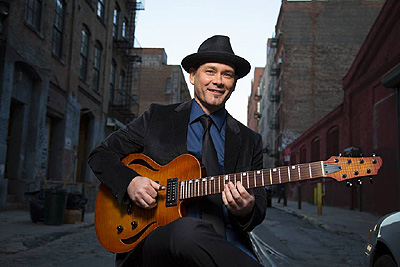 mwe3:
For jazz fusion fans, track 5 “Night Drive” will be a definite
highlight. You mention a car chase as inspiration. It does have that
driving beat and guitar sound. Are you influenced by soundtracks and
would you say that track has a kind of soundtrack or fusion quality
to it? Is that track your rock influence coming out?
mwe3:
For jazz fusion fans, track 5 “Night Drive” will be a definite
highlight. You mention a car chase as inspiration. It does have that
driving beat and guitar sound. Are you influenced by soundtracks and
would you say that track has a kind of soundtrack or fusion quality
to it? Is that track your rock influence coming out?
Adam Smale: Not inspired by a car chase, but a scenario of
driving a little to fast down an empty country road at night for sure.
The headlights and the canopy of the trees whipping by creating a
tunnel effect, then that song starts playing on the car stereo. A
“soundtrack approach” is how I write a majority of my songs.
More than any song on the CD, you can hear the most influence from
my very short lived fusion days. And I guess you could say it also
demonstrates that Holdsworth-ian, Coltrane-esque, sheets-of-sound
thing.
mwe3: Do you still practice guitar or do you spend more time
writing, playing live and arranging music? How else do you stay in
shape musically, both as a guitarist and a composer?
Adam Smale: I practice as much as I can during the week, anywhere
from 2-6 hours depending on the day. I haven’t really been writing
lately. I haven’t been inspired lately to write. Sometimes I
go for periods of time not composing, other times tunes come pouring
out. Right now I mostly am practicing playing through tunes, jazz
standards. Whether it’s learning a tune, or reviewing songs I
already know. I always have to revisit tunes. I don’t have a
photographic memory like some people seemingly do. Review, review.
mwe3: “Night Drive” is followed up by a quiet track
called “She Knows Me”. Is that the other side of your guitar
playing, the quieter and more subdued side and how does the Lenny
Breau sound influence that track and the more introspective tracks
on the Out Of The Blue CD?
Adam Smale: As I alluded to before, a lot of my compositions
are cinematic, at least in my mind. A movie scene plays out in my
mind, or that’s the closest I can describe it, then I write a
song, or soundtrack to that scene. “She Knows Me”, is a
ballad that is inspired from me envisioning a scene of unrequited
love. Where some one is passionately in love with a person from afar
and those same feelings aren’t reciprocated by that other person.
So this song represents that mixture of love, sadness, and sentimental
moods. I squeak in Lenny Breau’s cascading fretted harmonics
technique, where by you form a very “notey” lush chord,
and you pluck out the harmonic note with your right hand 12 frets
above the left hand fretted notes. Hard to explain, easier to demonstrate.
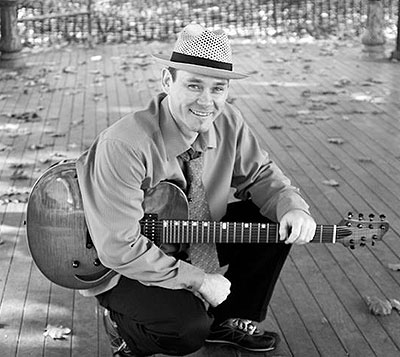 mwe3:
Who else was involved in the recording, producing, mixing and design
of the Out Of The Blue CD? How did you come up with the title for
the album and can you tell us something about the cover art, which
is great...
mwe3:
Who else was involved in the recording, producing, mixing and design
of the Out Of The Blue CD? How did you come up with the title for
the album and can you tell us something about the cover art, which
is great...
Adam Smale: Thanks! George Petit is responsible for both engineering
and mixing the music. I had to credit George as a producer as well,
because he really helped organize the session, crucial in setting
everything up, and keeping everybody on-track and focused. He also
had a huge influence decision on which takes would be chosen for the
final tunes to appear on Out Of The Blue.
A lot of people don’t realize this, but there was a second engineer,
Mauricio Gargel, on the session that recorded everything in 3D surround
sound. Who knows, maybe I will have a surround sound versions of some
or all of the songs to release one day.
It was mastered by Oscar Zambrano. He is a very talented guy at what
he does. I am sure I soon won’t be able to afford him.
Artwork fell to the hands of a fellow Canadian, the talented, Michael
Wrycraft. He single handedly captured the mood of the recording with
the look and feel of the art. Of course, that’s what he does.
He is one of Canada’s premiere artists for CD cover art and design.
I guess I was thinking people might be wondering “Who is this
guy?” “Where did he come from?” That’s why I decided
to call it Out Of The Blue? Furthermore, that’s where
a lot of my songs seem to come from as well, “out of the blue.”
It sometimes amazes me that the universe has handed me the tunes that
I can put my name on it as mine.
mwe3: Is “Autumn Confirmation” the more hard bop
side of your playing as in the Out Of The Blue liner notes
Bill Milkowski mentions the song was influenced by Charlie Parker.
How was Parker an influence on your jazz-based sound?
Adam Smale: Well the head is definitely very Bebop oriented.
The song is much more than being influenced by Charlie Parker. I’ll
explain. It started out as an experiment. I took the chord changes
to “Autumn Leaves”, superimposed Parker’s rhythms to
his melody from his song, “Confirmation”, and then wrote
in my own pitches, or notes, to those rhythms. It turned out so good
I started playing it live. And it finally ended up on Out Of The
Blue. I know quite a few Charlie Parker tunes. So yes, I would
say Charlie Parker has entered my musical consciousness a fair extent,
especially rhythmically. Another person who greatly influenced my
phrasing, I think, is Tal Farlow. Ever since I started listening to
Pat Martino, I noticed my picking attack and a little bit of phrasing
have taken on just a little bit of Pat’s more aggressive style
as well. I had a lesson with Pat Martino a couple of years ago. THAT,
was a cool experience!
mwe3: “NYC Love Affair” has a kind of rush-hour vibe
to it. I can just about picture millions of people rushing home from
work and the streets teaming with people rushing around town. You
mention the song was influenced by something called “triad pairing”.
Can you tell us more about what a triad pair is and how it shaped
the song?
 Adam
Smale: Yes, it’s a very busy melody. And that’s why
it reminded me of New York City. And one could take that title, “NYC
Love Affair”, as a love affair between two people occurring in
NYC, or a love affair with NYC itself. A double meaning as it were.
Triad Pairs is a technique used in improvising or melody writing,
where each chord in the progression can be expressed, or played on,
with two separate triads. A triad is a 3 note chord. So you can play
those 3 notes together (as a chord), or you can play the notes of
the triads separately (melodically). In this case we’re talking
about playing it melodically.
Adam
Smale: Yes, it’s a very busy melody. And that’s why
it reminded me of New York City. And one could take that title, “NYC
Love Affair”, as a love affair between two people occurring in
NYC, or a love affair with NYC itself. A double meaning as it were.
Triad Pairs is a technique used in improvising or melody writing,
where each chord in the progression can be expressed, or played on,
with two separate triads. A triad is a 3 note chord. So you can play
those 3 notes together (as a chord), or you can play the notes of
the triads separately (melodically). In this case we’re talking
about playing it melodically.
For example, take the first chord in the song, a Bb7. There are many
choices you could pick, but a popular one is, taking a Bb major triad
(Bb, D, & F), and an E major triad (E, G# & B). If you analyze
the notes in the first triad, you have an “inside” sound,
bland sounding notes, the Bb, D & F, the first 3 chord tones of
a Bb7. The second triad gives you the hipper, more colorful, “outside”
notes: E (#11), G# or Ab (b7), and lastly the B which is the b9. You
now have two sets of notes to play to take you inside and outside
the chord. It causes the ebb and flow of inside, outside. No tension,
tension/excitement, releasing back to no tension again. Just like
the hustle and bustle of New York.
The musicians might get that, but if you know nothing of music theory,
I might as well have been explaining how the Universe works in Swahili.
mwe3: In the Out Of The Blue liner notes you say that
the CD closing song “Original Sin” was influenced by Don
Grolnick. Can you tell us who Don Grolnick is and how he influenced
your music and the CD closer?
Adam Smale: Don Grolnick was a great pianist and keyboardist,
who kept active in the jazz, pop, and fusion worlds. He was an early
Brecker Brothers band member. He also was a composer. His compositions
often had a busy melody, followed by even larger spaces of no melody.
This took focus off the melody and allowed the rhythm section to be
the center of attention, even if it’s for 4 measures. Then this
back and forth musical tennis match created an interesting landscape
for the listener, both in a live or recorded setting. You could say
that this is a different kind of “tension and release” being
utilized compositionally. Unfortunately, Don left us too early. He
was roughly the age I am now when he passed.
 mwe3:
What else do you have planned for 2014 and into 2015? How about writing,
recording and live shows that you have planned and how you’re
planning to spread the word about Out Of The Blue among jazz and jazz
guitar fans?
mwe3:
What else do you have planned for 2014 and into 2015? How about writing,
recording and live shows that you have planned and how you’re
planning to spread the word about Out Of The Blue among jazz and jazz
guitar fans?
Adam Smale: I would really like to get out and perform more,
tour more, play in and around NYC more. But, alas, I need help with
booking. If there are any booking agents, or managers who want to
work with me, please contact me. Like many artists I struggle at maintaining
a routine to consistently hit places up to perform at. I’m not
lazy. It’s just hard to practice at home, teach at home, teach
other places, and too often be gigging nearly every night of the week
performing with other people. It can be quite a challenge to book
yourself. Booking can turn into a full-time job in itself. Then when
would I find time to practice and write when I’m inspired?
Thanks to Adam Smale @ www.AdamSmale-jazz.com
www.NewApproachToScales.com
www.facebook.com/adamsmale.jazz



